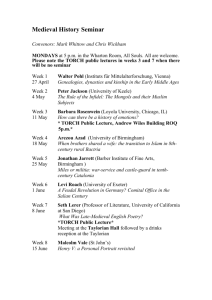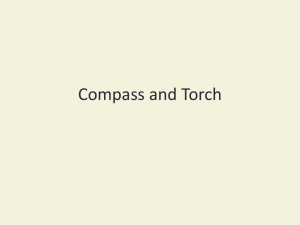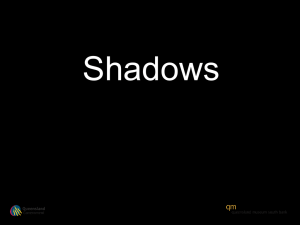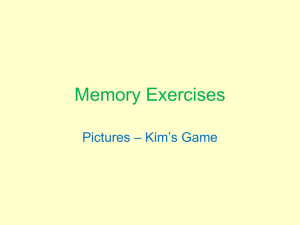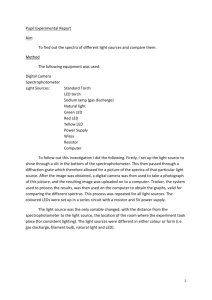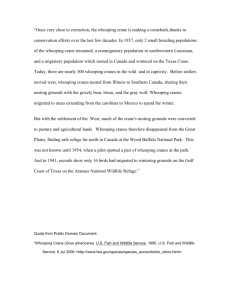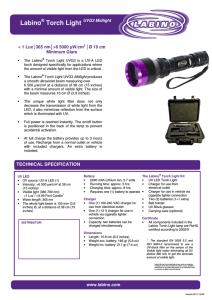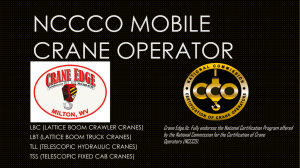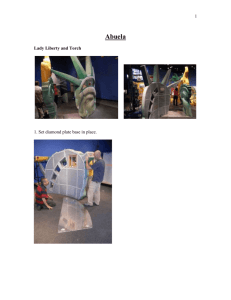Whooping Crane Partnership at the Milwaukee County Zoo
advertisement
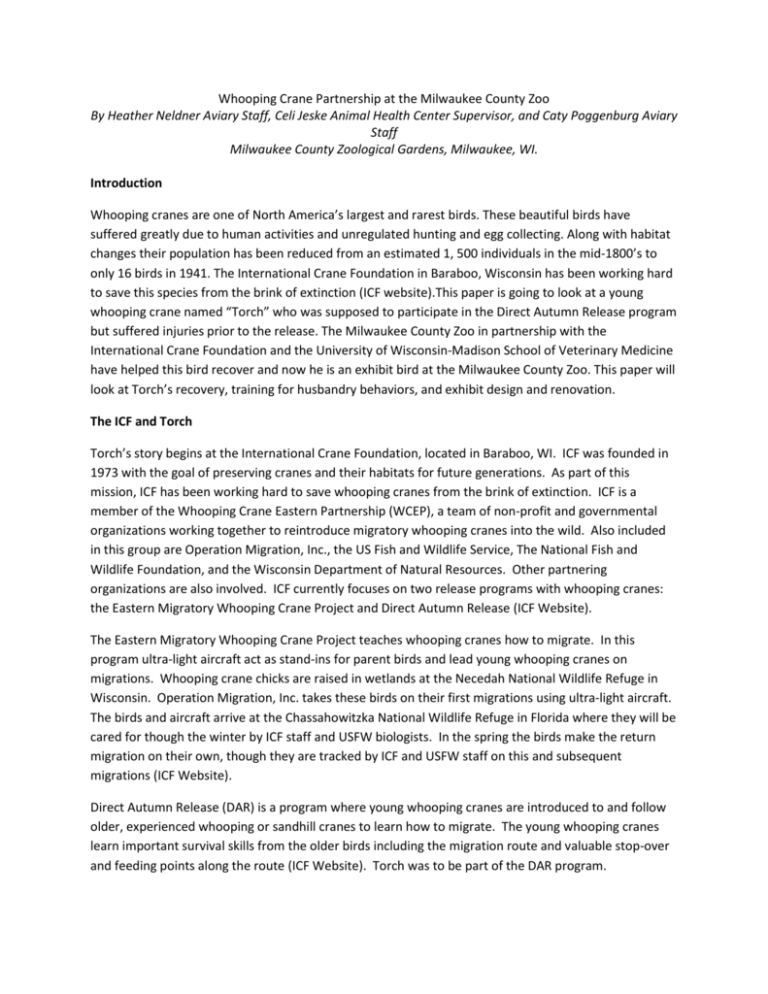
Whooping Crane Partnership at the Milwaukee County Zoo By Heather Neldner Aviary Staff, Celi Jeske Animal Health Center Supervisor, and Caty Poggenburg Aviary Staff Milwaukee County Zoological Gardens, Milwaukee, WI. Introduction Whooping cranes are one of North America’s largest and rarest birds. These beautiful birds have suffered greatly due to human activities and unregulated hunting and egg collecting. Along with habitat changes their population has been reduced from an estimated 1, 500 individuals in the mid-1800’s to only 16 birds in 1941. The International Crane Foundation in Baraboo, Wisconsin has been working hard to save this species from the brink of extinction (ICF website).This paper is going to look at a young whooping crane named “Torch” who was supposed to participate in the Direct Autumn Release program but suffered injuries prior to the release. The Milwaukee County Zoo in partnership with the International Crane Foundation and the University of Wisconsin-Madison School of Veterinary Medicine have helped this bird recover and now he is an exhibit bird at the Milwaukee County Zoo. This paper will look at Torch’s recovery, training for husbandry behaviors, and exhibit design and renovation. The ICF and Torch Torch’s story begins at the International Crane Foundation, located in Baraboo, WI. ICF was founded in 1973 with the goal of preserving cranes and their habitats for future generations. As part of this mission, ICF has been working hard to save whooping cranes from the brink of extinction. ICF is a member of the Whooping Crane Eastern Partnership (WCEP), a team of non-profit and governmental organizations working together to reintroduce migratory whooping cranes into the wild. Also included in this group are Operation Migration, Inc., the US Fish and Wildlife Service, The National Fish and Wildlife Foundation, and the Wisconsin Department of Natural Resources. Other partnering organizations are also involved. ICF currently focuses on two release programs with whooping cranes: the Eastern Migratory Whooping Crane Project and Direct Autumn Release (ICF Website). The Eastern Migratory Whooping Crane Project teaches whooping cranes how to migrate. In this program ultra-light aircraft act as stand-ins for parent birds and lead young whooping cranes on migrations. Whooping crane chicks are raised in wetlands at the Necedah National Wildlife Refuge in Wisconsin. Operation Migration, Inc. takes these birds on their first migrations using ultra-light aircraft. The birds and aircraft arrive at the Chassahowitzka National Wildlife Refuge in Florida where they will be cared for though the winter by ICF staff and USFW biologists. In the spring the birds make the return migration on their own, though they are tracked by ICF and USFW staff on this and subsequent migrations (ICF Website). Direct Autumn Release (DAR) is a program where young whooping cranes are introduced to and follow older, experienced whooping or sandhill cranes to learn how to migrate. The young whooping cranes learn important survival skills from the older birds including the migration route and valuable stop-over and feeding points along the route (ICF Website). Torch was to be part of the DAR program. Torch was hatched on June 8, 2006 and was puppet reared. Puppet rearing requires aviculturists to wear a large crane costume so that the chicks do not imprint on humans. A puppet crane head is controlled by the care giver to feed and interact with the chick. Torch spent the summer in the Necedah Wildlife area with other young cranes that were getting ready to be released. He was found with a severely injured wing on October 2, 2006. His wing was drooping so badly that he was stepping on his primary feathers. Radiographs showed that his left wing had a complete fracture of his humerus. ICF staff could not determine how he injured himself. Torch was taken to the University of WisconsinMadison School of Veterinary Medicine for surgery to repair his wing. He received intrameduallary pinning and a K-E apparatus and the wing was bandaged. He was returned to Necedah where he was placed on anti-inflammatory medication, antifungal medication, and antibiotics. At this point in time Torch was considered possibly unreleaseable and was transferred to the Milwaukee County Zoo on October 19, 2006 for long-term care. As part of the Whooping Crane Eastern Partnership, The Milwaukee County Zoo has offered to help care for any cranes that are injured during either the spring or fall migrations and has offered to help place birds that are unreleaseable. Torch is the first whooping crane that the zoo has taken for long term care. Torch’s Recovery When Torch arrived at the Milwaukee County Zoo, he was placed in quarantine at the Animal Health Center. He was housed in a large hoof stock stall with indoor and outdoor access. He was given straw on the floor of his stall and food was offered both inside and outside. Torch preferred to stay outside most of the time, often foraging for insects in the straw. Keepers would wear a crane costume that was loaned to us from ICF to care for Torch, spending time with him to encourage him to eat. Torch would often make contented trilling noises when he was with the costumed keeper. Torch had a bandage change shortly after his arrival at the zoo. Radiographs of his wing were taken at the beginning of November, his health status was noted, and his wing was rebandaged again. Three weeks later, radiographs showed that his wing was healing nicely. At the end of November, the intermaduallary pin was removed from his left humerus. He had a bridging callus starting at the fracture site but the fracture was still visible. The K-E apparatus was left in place and his wing was rebandaged. On December 14, the K-E apparatus and associated pins were removed from his wing. Five days later, blood work showed that his apsergillus antibody count was high and he was started on itraconazole. By mid-January of 2007, radiographs indicated that the fracture continued to heal well; his pin holes were becoming mineralized, and the fracture line was less visible. Although his fracture was healing, and he was considered capable of limited flight in the future, he was determined incapable to undertake the rigors of migration. A recheck of blood work at this time also showed his aspergillis antibody count was normal and the itraconazole treatment was discontinued. Throughout this process, ICF was kept informed and helped to make decisions on his care and treatments. In addition to his broken wing, Torch had a minor dietary problem. Shortly after Christmas, zookeepers noted that his pellet consumption was lower than normal, although his weight appeared stable. Staff reduced the amount of insects in his diet to encourage him to eat his pellets. In February 2007, zoo staff tried to switch Torch’s diet from Ziegler crane pellets to Mazuri crane pellets, which is the type of pellet we fed to our Demoiselle crane. By the time his diet was 50:50 Mazuri/Ziegler pellets, supplemented with whole and cracked corn kernels, Torch began to lose weight. Once it became clear that Torch would not eat the pellets, the zoo kept him on the diet of Ziegler pellets, which are obtained from ICF. On May 22, at eleven and a half months, Torch was moved to the Wong Family Pheasantry where he would be displayed. His primary feathers were trimmed on his right wing per ICF’s request. There was some concern that he might take flight and injure himself on the netting that encloses the crane yard. At this time his juvenile brown feathers were fading away to the white adult feathers and black was coming in on his wings. Although there is a decreased range of motion in his left wing, he is essentially healthy. Torch’s Housing The Milwaukee County Zoo offered to provide Torch with a permanent home in accordance with ICF and USFW (Torch is on loan from the US Fish and Wildlife Service). The Milwaukee County Zoo previously housed Demoiselle cranes in the Wong Family Pheasantry and it was decided this was where Torch would be displayed. A few modifications were needed to make it suitable for the whooping crane. The pheasantry consisted of a chain link mesh structure that enclosed three yards. Each yard was separated from the other yards by chain link mesh. Along the mesh plantings were used as visual barriers. Each yard had a shed that the animals could access for food and shelter. The two smaller yards each contained pheasants: a pair of silver pheasants in one and a female satyr tragopan in the other. The largest yard (the former Demoiselle crane yard) was designed to hold a pair of Demoiselle cranes and a pair of golden pheasants. The zoo no longer housed cranes, and the zoo worked with ICF to renovate the crane yard to make it more suitable for Torch. The decision was made to no longer display the satyr tragopan and golden pheasants. The silver pheasants would remain in the smaller end yard. The other two yards were combined to form one large yard. The wire mesh that separated the exhibits was removed and tennis netting was added along the mesh separating the crane yard from the silver pheasant yard. The tennis netting serves as a visual barrier and offers the pheasants protection from Torch in case he decides to jab at them. The newly renovated crane yard has a shed in the yard and access to a two-stalled heated barn where Torch can be locked in at night and/or during exhibit maintenance. The barn is accessed through a series of doors and vestibules (however the crane does not have free access to the barn since the vestibule is not predator-proof). The stalls in the barn are chain link and separated by a sliding chain link shift door. This arrangement allows the zoo to house two different animals, or to keep one animal secure on one side of the barn while a keeper is working on the other side. One side of the barn (where Torch spends the most time when he is inside) is covered with about 2 to 3 inches of pine shavings and the other side is covered with dri-deck to prevent foot issues. The doors to the original pheasant sheds were removed to allow Torch to access them for food, water, and shelter from the elements. In warm weather the floors of the sheds are usually just bare concrete so we can hose them clean. In the winter we place mulch on the floors of the sheds to keep his feet from getting frostbite. We also have an ICF recommended water heater that is plugged into the shed to keep his water from freezing. The crane yard is covered with mulch and there are several large rocks and a few logs to stand on in the yard. There had been several plantings in the yard, some of which were removed since ICF told us that whooping cranes can be very clumsy and get entangled in plantings. New vegetation was added which helps to break up the yard and add visual interest. Currently the yard contains some small arborvitae, a cedar tree, another small tree, trumpet vine and some large grasses. The vegetation also serves as enrichment for Torch as he loves to play in and destroy the grasses. The pool that was originally in the yard was too deep for the crane to use, so it was removed and a new pool was put in. The new pool is about five feet long by four feet wide. It has a gradual slope and is about 6 inches deep. Smooth river rock was incorporated into the concrete bottom to help prevent foot issues. Torch spends most of his time in the pool when the weather is nice, and he has presented us with several pool challenges. The pool drain leaks and requires a plastic cap placed over the drain so that the pool will hold water. If Torch can see this plastic cap, he grabs it and smashes it to bits! We have discovered that if he can’t see it, he leaves it alone. So we have to place very large, very heavy rocks over the plastic cap (we have also learned that Torch can move rocks of a fairly large size). Torch has also figured out how to operate the knife valve for the water fill. He has successfully flooded his exhibit and the service drive behind the exhibit on numerous occasions. Torch had so much fun with this game that we ended up having to remove the fill valve handle. We now only take it out to the yard when we are cleaning and refilling the pool. Torch loves his pool and any “treasure” he finds ends up in it. Keepers are often greeted with various items Torch has dug up from his yard. The most memorable has been several pieces of garter snake. Torch’s Training Torch is very smart and eager to learn. However, as with many intelligent animals, he can be very stubborn if he does not want to do something. He definitely tests some keepers and is really good for others. He is food motivated, which helps with training. Torch’s favorite treats include pinkie mice, mighty mealworms, wax worms, grapes, cranberries, smelt, silversides, capelin, blueberries, apple, pear, melon, cracked corn, and live crickets. His favorite items seem to be grapes, pinkies, mighty mealworms, wax worms, and crickets. He seems to go in phases – sometimes he really likes an item while at other times he will not touch it. We have to rotate treats frequently. Our first experience with training Torch was for weighing at the Animal Health Center when he first came to the zoo. It was decided to train him for weighing because he was having a hard time adjusting to new pellets being offered and with the frequent handling the veterinarians wanted to be sure he was gaining and keeping weight on. He was scale-trained using a small wooden platform. He had access to this platform in the hoof stock stall and would stand on it randomly. The keepers began putting wax worms on the platform and he was encouraged to stand on it on cue. Torch was then introduced to a small scale, which was the same size as the platform. The scale has a slick metal surface, so a square of carpet was added for better traction. Once he stood on it he received a reward of wax worms as his weight was recorded. Soon he was standing on the carpeted scale reliably. Once Torch was on display, the keepers realized that we also needed to train Torch to go willingly into and out of the barn. It is important that Torch can be shifted quickly and reliably if we have severe weather or if we need to access the yard. We have also decided that it is better for Torch to be shifted inside his barn if anyone needs to service his yard for our safety and for his. The carpet square proved to be very helpful when training him to go into and out of the barn. To teach him to go into and out of the barn, a keeper wearing safety glasses and armed with lots of his favorite treats would go into the yard with Torch and have him follow them. Torch caught on to this game quickly and would follow the keeper anywhere for treats. The only thing that made him really nervous was the metal kick plate on the door to the vestibule. He would have to step on this to get into the vestibule and then walk down the short corridor to get into the barn. He would hesitate every time he’d get near the kick plate and even with treats and praise he would not go over it. To solve this problem we placed his carpet square over the kick plate and called him into the corridor. He eagerly followed his keeper right into the barn. We repeated this several times to build up his confidence and then removed the carpet square. He was reluctant to step on the kick plate but with lots of praise he did it and went right into the barn. To make it even easier for keepers who do not work with Torch often, we trained him to come all the way into the barn for treats when he hears the sound of bell ringing. We no longer need to use the bell to get him into the barn, but it is still an option for keepers who don’t work with him all the time. We were able to teach him all of this in only a few days. He can, however, be stubborn sometimes and has to be herded into the barn simply because he does not want to go in. We have started an enrichment program with the whooping crane with limited success. He has a few toys that he likes to play with, like his large orange boomer ball and wicker ball. He loves to forage for crickets if they are scattered in the yard or in the shavings in the barn. He loves his pool and water dish, any “treasure” he finds, toys and sticks all end up in the water. Torch finds anything and everything buried in his yard. Torch on Display Torch has proven to be a very good exhibit bird and is extremely popular with the public. He is very curious and outgoing and often approaches the front of his exhibit when people come by. The zoo has put up lots of educational graphics about whooping cranes, about Torch in particular, and about ICF and their reintroduction programs. We see the public reading the signs all the time and often ask keepers questions about him. Wisconsin can be cold in the winter, but we have had no problem with Torch handling cold temperatures or snow while on display. Whooping cranes are winter hardy and can handle temperatures to minus 30 degrees (Ellis, Gee, and Mirande p.33). Torch prefers to stand on shoveled areas, so when it snows the keepers make several paths through his yard. The only problem we have had with winter had nothing to do with the crane, just his exhibit. We had a huge problem at the beginning of February with 11 inches of wet snow falling in less than 24 hours. The huge weight of the snow caused the mesh roof of the crane yard to become so heavy that it snapped the support beams. The mesh roof caved in. In some spots of the crane yard we had less than five feet of “head room”. Luckily Torch’s training came in handy as he quickly came into the barn when called. He was held in the barn for two days and it was decided that it was unsafe for him to be in the yard. He was relocated to our brand new flamingo building (we don’t have flamingos yet) until his exhibit can be repaired. Once his exhibit is repaired, Torch will once again be on display as one of the exhibit animals most liked by the public as well as his keepers. Sources: International Crane Foundation Site 12 Dec. 2007. <www.savingcranes.org/conservation> Ellis, David H, George F. Gee, Claire M. Mirande. Cranes: Their Biology, Husbandry and Conservation. Washington DC: Department of the Interior, National Biological Service and Baraboo, WI : International Crane Foundation, 1996. Acknowledgements and Thank You: US Fish and Wildlife Service International Crane Foundation Staff University of Wisconsin-Madison Veterinary Hospital Milwaukee County Zoo Veterinary Staff and Technicians Dr. Gretchen Cole D.V.M Ellen Saksefski-Aviary Supervisor Kim Smith-former Bird Curator at the Milwaukee County Zoo All the Milwaukee County Zoo zookeepers who were involved with Torches’ care and recovery
